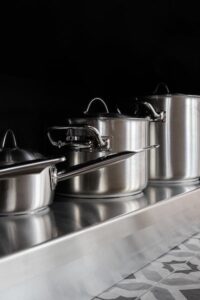 There are many types of stainless steel grades. In fact, over 150 grades have been designated for one purpose or another. Though the many grades of stainless steel share some characteristics, it is the near-endless combination of alloying metals that differentiates one grade from another. Still, of all the types of stainless steel grades available on the market, only a dozen or so grades are used for the majority of industrial, building, or commercial applications. Of those, only a handful of grades are utilized in the formation of spring wire.
There are many types of stainless steel grades. In fact, over 150 grades have been designated for one purpose or another. Though the many grades of stainless steel share some characteristics, it is the near-endless combination of alloying metals that differentiates one grade from another. Still, of all the types of stainless steel grades available on the market, only a dozen or so grades are used for the majority of industrial, building, or commercial applications. Of those, only a handful of grades are utilized in the formation of spring wire.
Stainless steels are iron-based alloys that, essentially, consist of low carbon steel that contains a minimum chromium content of 10.5%. The addition of chromium provides a protective oxide layer that gives this group of steels its most well-known property—corrosion resistance. Stainless steels, however, offer much more than simply corrosion resistance. It is a versatile metal alloy, durable and affordable; easily welded, has high strength, increased formability, as well as an overall attractive appearance. Once put into service, it requires low maintenance and does not need to be further treated, coated or painted unless by choice.
There are families of stainless steel that hold specific properties—Austenitic, Ferritic, Duplex and Martensitic are the most prevalent—but overall it is the grading system that separates one type of stainless steel from another. There are different grading systems used around the world. In North America, a standard alloy numbering system conceived by the Society of Automotive Engineers (SAE) features the familiar three-digit identifier. Such recognizable stainless steel grades as the 300 series or 400 series are derived from the SAE steel grade system.
Various grades of stainless steel help to describe the specific properties required for an application. In general, stainless steel spring wires must provide a high tensile strength in combination with good to superior corrosion resistance, durability is a must, and magnetic properties where needed. Corrosion resistance and other useful properties of stainless steel can be enhanced by increased chromium content with the addition of other elements such as molybdenum, nickel, cobalt and magnesium.
The most popular grades of stainless steel wires used in manufacturing applications are type 17-7, type 302/304, type 316, and the new ‘super-alloy,’ Elgiloy. Let’s have a closer look:
Type 17-7
The 17-7 grade is a precipitation-hardening (PH) stainless steel that provides exceptional strength and hardness, along with excellent fatigue properties, good corrosion resistance, and formability. Type 17-7 stainless steel is not designated on the older SAE grade system. The grade name is derived from its 17% chromium and 7% nickel content. Other elements found in 17-7 PH are manganese and aluminum. Its high strength and good corrosion resistance, as well as excellent properties for high temperatures up to 316°C (600°F), make it ideal for spring applications. The chemistry of this stainless alloy offers properties well suited for applications in the aerospace, automotive, and chemical processing industries.
Type 302/304
The Type 302/304 stainless steel grade is a general-purpose stainless alloy typically composed of 18% Chromium and 8% Nickel. In fact, as with 17-7 stainless steel, 304 stainless steel is sometimes referred to as 18-8 due to its chromium and nickel composition. Because of its high corrosion resistance and good tensile strength, it is the most widely used stainless steel alloy for springs. It holds slight magnetic properties, too, offers good heat resistance and maintains its strength at temperatures up to 288°C (550°F). Type 302/304 stainless steel spring components are widely used in a variety of household and commercial applications, in industrial-grade food processing equipment, in the automotive and aerospace industries, and for applications in the medical industry.
Type 316
The 316 stainless steel is an austenitic chromium-nickel stainless steel with the addition of 2% to 3% molybdenum. This chemistry offers increased resistance to corrosion and pitting, which makes this grade well-suited for high chloride environments where structural pitting and crevices are more likely to occur. Though the properties are similar to 302/304, 316 exhibits better corrosion resistance than 302/304. It has good creep resistance and tensile strength, and outstanding formability and weldability. Type 316 is used for spring applications in corrosive environments—specifically in applications that do not require high impact or load strength—for aerospace, chemical processing, food processing, energy, and general manufacturing. Spring components are found in mechanical devices used in chemical processing equipment, in marine industry valves and pumps, in pharmaceutical and textile equipment, food preparation equipment, and in laboratories and pollution control equipment.
Elgiloy
Elgiloy is a relatively recent addition to the grades of stainless steel. It has been dubbed a ‘super-alloy,’ consisting of cobalt, chromium, nickel, molybdenum, iron and magnesium. Holding an edge over more common stainless steel, the material is well-regarded for its exceptional mechanical properties comparable to high carbon spring steel. As a common spring material, it offers very high strength, ductility, exceptional formability, excellent corrosion resistance in harsh environments, and high fatigue strength. Elgiloy performs in wide temperature extremes from cryogenic up to 850°F (454°C). In chloride environments, it resists crevice and stress corrosion and pitting, and is highly resistant to sulfide stress corrosion cracking. The material is biocompatible with non-magnetic properties, which makes it ideal for components in a range of medical devices from stents and pacemakers to surgical clips and dental implants. Elgiloy is a common spring material for oil and gas applications.

